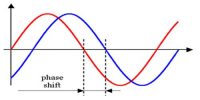Progressive waves transfer energy from one place to another, without transferring the matter. Stationary waves do not transfer energy from one place to another. Besides, Progressive waves bring a net amount of energy through the path of the wave. A stationary wave does not carry net energy through the path.
Difference between Progressive and Stationary Waves are:
Progressive Waves – A progressive wave moves away from the source, or it moves relative to a coordinate system in a fluid, or it advances on the sea surface or at an intermediate depth. They are those waves having visible disturbances meaning the vibrations can be seen moving throughout the material.
- Every particle of the medium executes periodic motion.
- The amplitude of each particle of the medium is the same, but there exits phase difference between them.
- The distance between two successive crests of a transverse wave and distance between compression and rarefaction is a wavelength.
- The changes in pressure and density of the medium are similar in case of progressive waves.
- In a progressive wave, the particle of the medium wave attains a stationary position.
- The amplitude of each partied is the same but the phase changes continuously,
- In the case of a longitudinal progressive wave, all the parts of the medium undergo a similar variation of density one after the other.
- Progressive wave move through the medium transferring energy from
the source to a point away. - In progressive waves, the amplitudes of any two particles which are in phase are the same.
- Phases of the progressive waves of the particles in these waves are varying in a continuous manner and have changing values between them.
- The equation of a progressive wave is,
![]()

Stationary Waves – A stationary or standing wave remains in a constant position. These waves are produced when two waves interfere this results in an invisible disturbance though the wave is moving throughout the material. These waves consist of two different points known as nodes and antinodes.
- Only the particles other than those at the nodes executes periodic motion.
- The phase difference between particles of the medium is the same, but the amplitude is different.
- The distance between three successive nodes or anti-nodes is called a wavelength.
- In case of a stationary wave, pressure and density remain almost unchanged at the nodes, while the changes are minimal at the anti-nodes.
- In case of a stationary wave, each particle attains its stationary position twice during one complete vibration.
- The amplitudes of the different particles are different, ranging from zero at the nodes to maximum at the antinodes.
- In the case of a longitudinal stationary wave, the variation of density is different at different points being maximum at the nodes and zero at the antinodes.
- A stationary wave does not move through the medium hence does not transfer any energy from the source while
- In stationary wave the amplitudes of particles between successive nodes are different.
- Phases of the Stationary or standing waves of the particles in these waves are not changing and always same to the contrary opposite when placed between the consecutively running sets of nodes.
- The equation of a stationary wave is,
![]()















